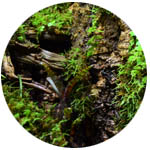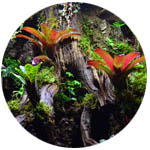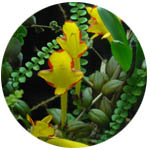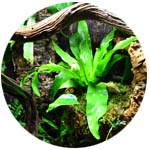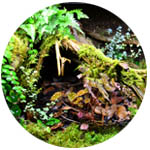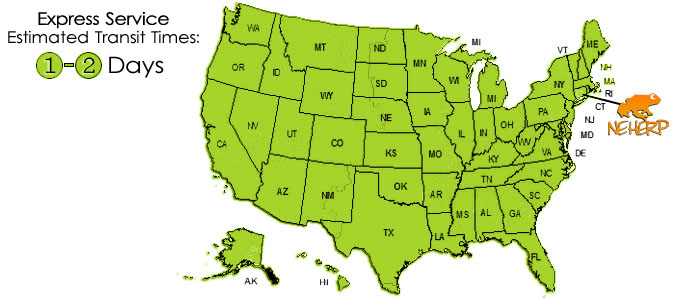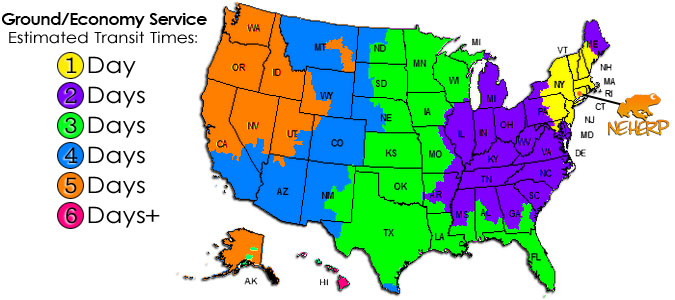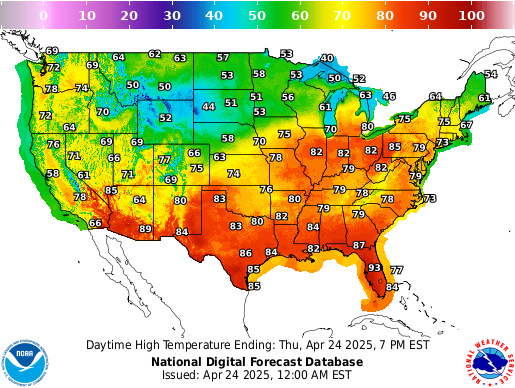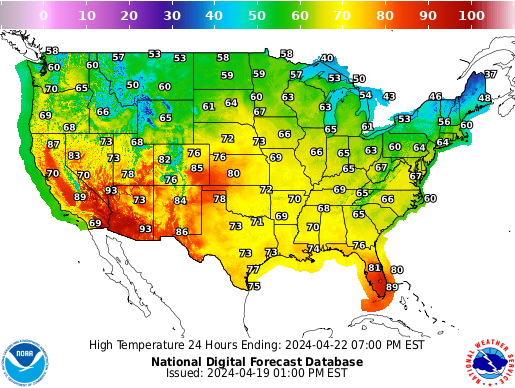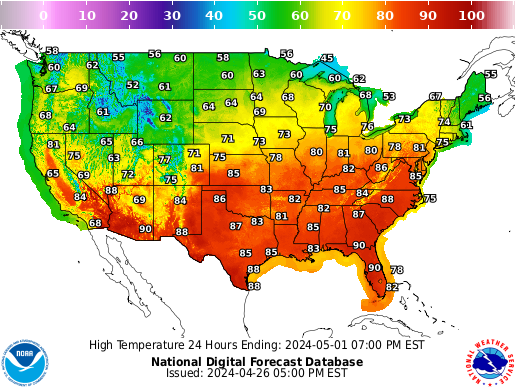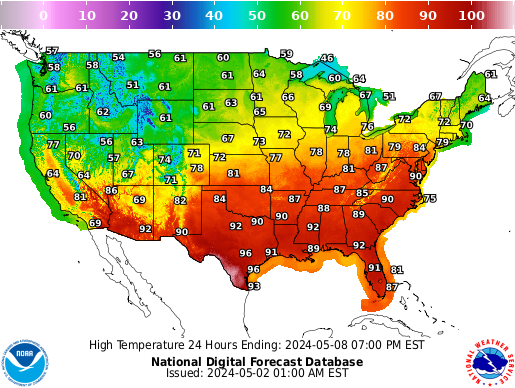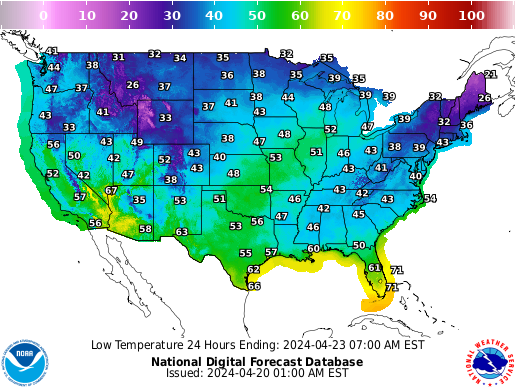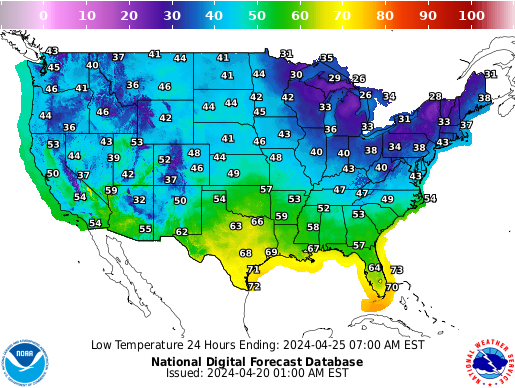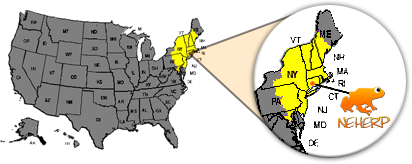Sansevieria
Live Snake Plants For Terrariums & Vivariums
About Our Sansevieria
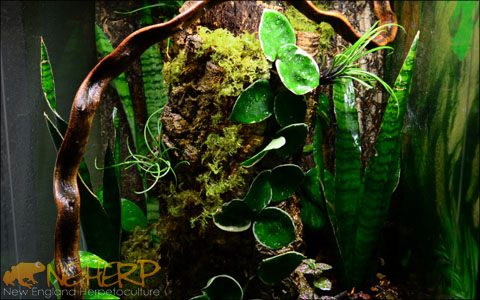
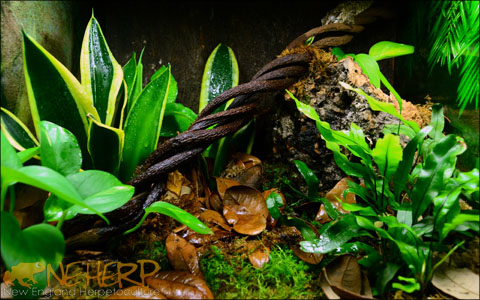
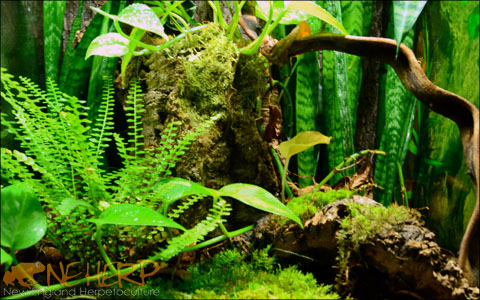
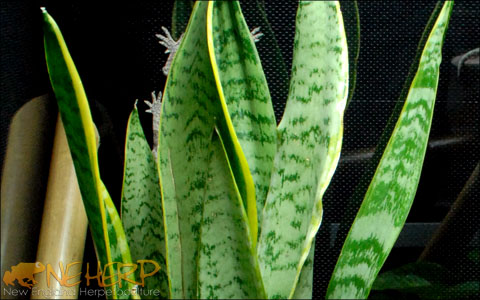
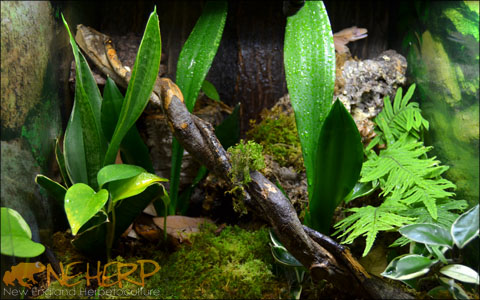
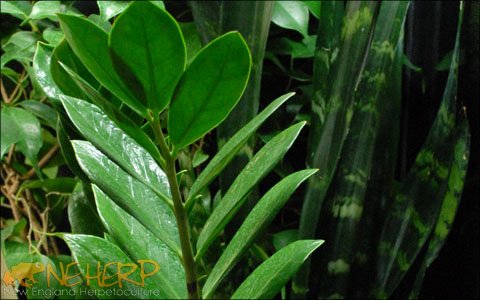
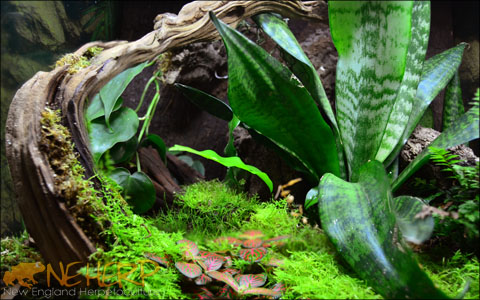
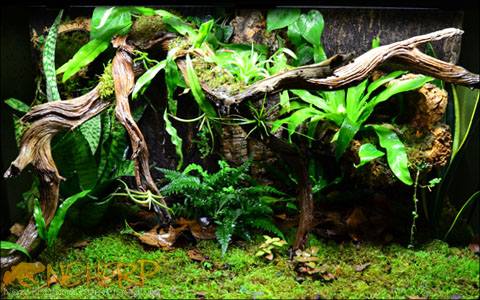
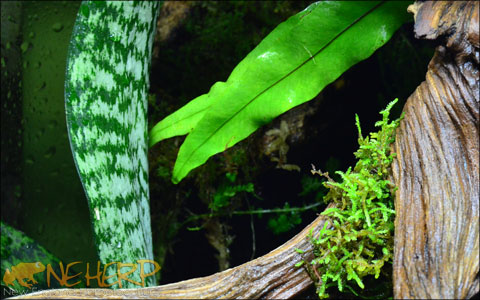
Plant Size Info
Potted Plants:


Live Mats:


Rooted Portions:

Clippings:

Sansevieria trifasciata 'Black Gold'
Mother-In-Law's Tongue
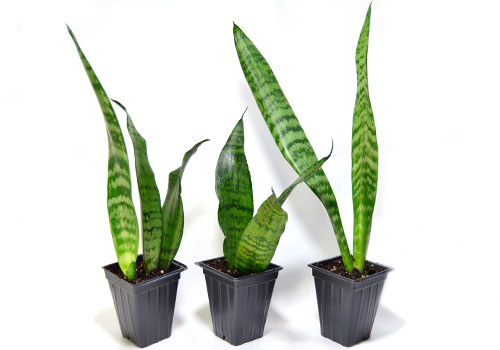
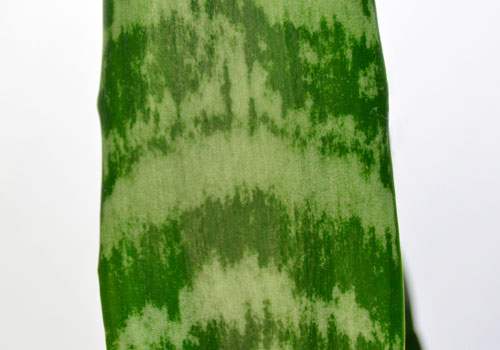
 Seriously though, this plant will thrive in an extremely wide variety of conditions, and so long as it's got access to at least some natural light & occasional watering sessions, a Sansevieria plant will thrive. In an enclosure, we recommend planting it where it'll have plenty of upward room to grow, and ensuring it's planted deep enough to prevent the plant tipping over. Within a few weeks (in ideal conditions), the plant will spread it's roots and do a great job of supporting itself even with a Gecko or Frog climbing on it. It's leaves will widen with age, starting just an inch or two across, and eventually growing to 4in or so across in some vivarium environments. Pruning these slow-growing plants is as simple as giving them a slice towards the top of each leaf. By following the natural shape of the plant, the trimmed end won't look especially out-of-place. The pictured plants are growing in 3in pots.
Seriously though, this plant will thrive in an extremely wide variety of conditions, and so long as it's got access to at least some natural light & occasional watering sessions, a Sansevieria plant will thrive. In an enclosure, we recommend planting it where it'll have plenty of upward room to grow, and ensuring it's planted deep enough to prevent the plant tipping over. Within a few weeks (in ideal conditions), the plant will spread it's roots and do a great job of supporting itself even with a Gecko or Frog climbing on it. It's leaves will widen with age, starting just an inch or two across, and eventually growing to 4in or so across in some vivarium environments. Pruning these slow-growing plants is as simple as giving them a slice towards the top of each leaf. By following the natural shape of the plant, the trimmed end won't look especially out-of-place. The pictured plants are growing in 3in pots.
| ▾ General Plant Info ▾ | |||||
|---|---|---|---|---|---|
| Difficulty | Adult Size | USDA Zone | Endemic Region(s) | ||
| Very Easy | 24-48in | 11-12 | Tropical Africa (Nigeria) | ||
| Lighting | Soil pH | Nutrients | Water | ||
| Partial shade to filtered sun | 5.5-7.0 | Mild, balanced | Allow to dry slightly before watering | ||
| ▾ Vivarium Specific Plant Info ▾ | |||||
| Vivarium Lighting | Vivarium Substrate | Vivarium Maintenance | Vivarium Placement | ||
| Widely tolerant (Any Lighting Kit) |
ABG, V1, or V2 (Any Substrate Kit) |
Semi-Infrequent Expect To Trim Bi-Monthly/Quarterly |
Terrestrial / Allow room for upward growth (See VC101's Plant Section For Tips!) |
||
Nutrient data listed for houseplant care only. Additional nutrients are not typically required in properly designed live vivaria.


Sansevieria trifasciata 'Gold Hahnii'
Variegated Bird's Nest Sansevieria
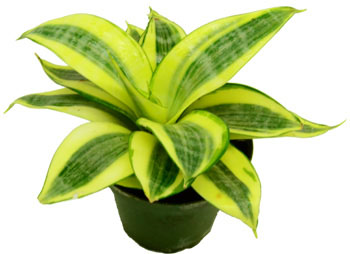
| ▾ General Plant Info ▾ | |||||
|---|---|---|---|---|---|
| Difficulty | Adult Size | USDA Zone | Endemic Region(s) | ||
| Very Easy | 8in | 11-12 | N/A (Cultivar) | ||
| Lighting | Soil pH | Nutrients | Water | ||
| Partial shade to filtered sun | 5.5-7.0 | Mild, balanced | Allow to dry slightly before watering | ||
| ▾ Vivarium Specific Plant Info ▾ | |||||
| Vivarium Lighting | Vivarium Substrate | Vivarium Maintenance | Vivarium Placement | ||
| Widely tolerant (Any Lighting Kit) |
ABG, V1, or V2 (Any Substrate Kit) |
Semi-Infrequent Expect To Trim Bi-Monthly/Quarterly |
Terrestrial / Allow space for growth (See VC101's Plant Section For Tips!) |
||
Nutrient data listed for houseplant care only. Additional nutrients are not typically required in properly designed live vivaria.
3in Pot

3in Pot
4in Pot

4in Pot
3in Pot

3in Pot
4in Pot

4in Pot

Sansevieria trifasciata 'Laurentii'
Mother-In-Law's Tongue
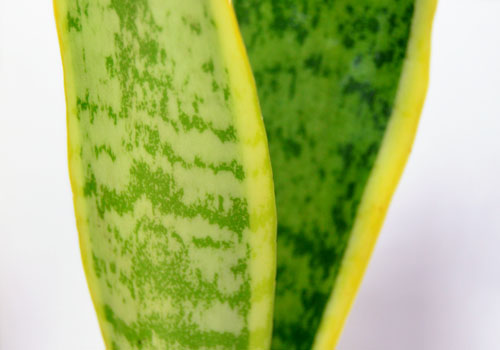
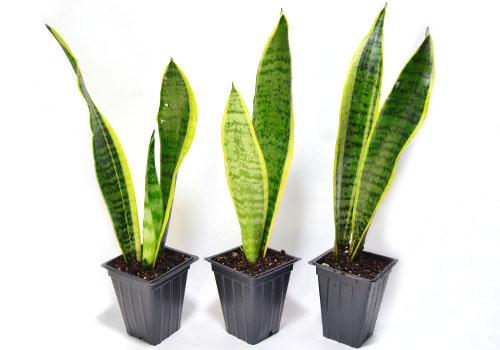
 Seriously though, this plant will thrive in an extremely wide variety of conditions, and so long as it's got access to at least some natural light & occasional watering sessions, a Sansevieria plant will thrive. In an enclosure, we recommend planting it where it'll have plenty of upward room to grow, and ensuring it's planted deep enough to prevent the plant tipping over. Within a few weeks (in ideal conditions), the plant will spread it's roots and do a great job of supporting itself even with a Gecko or Frog climbing on it. It's leaves will widen with age, starting just an inch or two across, and eventually growing to 4in or so across in some vivarium environments. Pruning these slow-growing plants is as simple as giving them a slice towards the top of each leaf. By following the natural shape of the plant, the trimmed end won't look especially out-of-place. The pictured plants are growing in 3in pots.
Seriously though, this plant will thrive in an extremely wide variety of conditions, and so long as it's got access to at least some natural light & occasional watering sessions, a Sansevieria plant will thrive. In an enclosure, we recommend planting it where it'll have plenty of upward room to grow, and ensuring it's planted deep enough to prevent the plant tipping over. Within a few weeks (in ideal conditions), the plant will spread it's roots and do a great job of supporting itself even with a Gecko or Frog climbing on it. It's leaves will widen with age, starting just an inch or two across, and eventually growing to 4in or so across in some vivarium environments. Pruning these slow-growing plants is as simple as giving them a slice towards the top of each leaf. By following the natural shape of the plant, the trimmed end won't look especially out-of-place. The pictured plants are growing in 3in pots.
| ▾ General Plant Info ▾ | |||||
|---|---|---|---|---|---|
| Difficulty | Adult Size | USDA Zone | Endemic Region(s) | ||
| Very Easy | 24-48in | 11-12 | Tropical Africa (Nigeria) | ||
| Lighting | Soil pH | Nutrients | Water | ||
| Partial shade to filtered sun | 5.5-7.0 | Mild, balanced | Allow to dry slightly before watering | ||
| ▾ Vivarium Specific Plant Info ▾ | |||||
| Vivarium Lighting | Vivarium Substrate | Vivarium Maintenance | Vivarium Placement | ||
| Widely tolerant (Any Lighting Kit) |
ABG, V1, or V2 (Any Substrate Kit) |
Semi-Infrequent Expect To Trim Bi-Monthly/Quarterly |
Terrestrial / Allow room for upward growth (See VC101's Plant Section For Tips!) |
||
Nutrient data listed for houseplant care only. Additional nutrients are not typically required in properly designed live vivaria.


Sansevieria trifasciata 'Moon Shine'
Mother-In-Law's Tongue

 Seriously though, this plant will thrive in an extremely wide variety of conditions, and so long as it's got access to at least some natural light & occasional watering sessions, a Sansevieria plant will thrive. In an enclosure, we recommend planting it where it'll have plenty of upward room to grow, and ensuring it's planted deep enough to prevent the plant tipping over. Within a few weeks (in ideal conditions), the plant will spread it's roots and do a great job of supporting itself even with a Gecko or Frog climbing on it. It's leaves will widen with age, starting just an inch or two across, and eventually growing to 4in or so across in some vivarium environments. Pruning these slow-growing plants is as simple as giving them a slice towards the top of each leaf. By following the natural shape of the plant, the trimmed end won't look especially out-of-place. The pictured plants are growing in 3in pots.
Seriously though, this plant will thrive in an extremely wide variety of conditions, and so long as it's got access to at least some natural light & occasional watering sessions, a Sansevieria plant will thrive. In an enclosure, we recommend planting it where it'll have plenty of upward room to grow, and ensuring it's planted deep enough to prevent the plant tipping over. Within a few weeks (in ideal conditions), the plant will spread it's roots and do a great job of supporting itself even with a Gecko or Frog climbing on it. It's leaves will widen with age, starting just an inch or two across, and eventually growing to 4in or so across in some vivarium environments. Pruning these slow-growing plants is as simple as giving them a slice towards the top of each leaf. By following the natural shape of the plant, the trimmed end won't look especially out-of-place. The pictured plants are growing in 3in pots.
| ▾ General Plant Info ▾ | |||||
|---|---|---|---|---|---|
| Difficulty | Adult Size | USDA Zone | Endemic Region(s) | ||
| Very Easy | 24-48in | 11-12 | Tropical Africa (Nigeria) | ||
| Lighting | Soil pH | Nutrients | Water | ||
| Partial shade to filtered sun | 5.5-7.0 | Mild, balanced | Allow to dry slightly before watering | ||
| ▾ Vivarium Specific Plant Info ▾ | |||||
| Vivarium Lighting | Vivarium Substrate | Vivarium Maintenance | Vivarium Placement | ||
| Widely tolerant (Any Lighting Kit) |
ABG, V1, or V2 (Any Substrate Kit) |
Semi-Infrequent Expect To Trim Bi-Monthly/Quarterly |
Terrestrial / Allow room for upward growth (See VC101's Plant Section For Tips!) |
||
Nutrient data listed for houseplant care only. Additional nutrients are not typically required in properly designed live vivaria.


 All Plants Below Are Sold Out Or Reserved
All Plants Below Are Sold Out Or Reserved 







Sansevieria trifasciata 'Black Gold'
Mother-In-Law's Tongue


 Seriously though, this plant will thrive in an extremely wide variety of conditions, and so long as it's got access to at least some natural light & occasional watering sessions, a Sansevieria plant will thrive. In an enclosure, we recommend planting it where it'll have plenty of upward room to grow, and ensuring it's planted deep enough to prevent the plant tipping over. Within a few weeks (in ideal conditions), the plant will spread it's roots and do a great job of supporting itself even with a Gecko or Frog climbing on it. It's leaves will widen with age, starting just an inch or two across, and eventually growing to 4in or so across in some vivarium environments. Pruning these slow-growing plants is as simple as giving them a slice towards the top of each leaf. By following the natural shape of the plant, the trimmed end won't look especially out-of-place. The pictured plants are growing in 3in pots.
Seriously though, this plant will thrive in an extremely wide variety of conditions, and so long as it's got access to at least some natural light & occasional watering sessions, a Sansevieria plant will thrive. In an enclosure, we recommend planting it where it'll have plenty of upward room to grow, and ensuring it's planted deep enough to prevent the plant tipping over. Within a few weeks (in ideal conditions), the plant will spread it's roots and do a great job of supporting itself even with a Gecko or Frog climbing on it. It's leaves will widen with age, starting just an inch or two across, and eventually growing to 4in or so across in some vivarium environments. Pruning these slow-growing plants is as simple as giving them a slice towards the top of each leaf. By following the natural shape of the plant, the trimmed end won't look especially out-of-place. The pictured plants are growing in 3in pots.
| ▾ General Plant Info ▾ | |||||
|---|---|---|---|---|---|
| Difficulty | Adult Size | USDA Zone | Endemic Region(s) | ||
| Very Easy | 24-48in | 11-12 | Tropical Africa (Nigeria) | ||
| Lighting | Soil pH | Nutrients | Water | ||
| Partial shade to filtered sun | 5.5-7.0 | Mild, balanced | Allow to dry slightly before watering | ||
| ▾ Vivarium Specific Plant Info ▾ | |||||
| Vivarium Lighting | Vivarium Substrate | Vivarium Maintenance | Vivarium Placement | ||
| Widely tolerant (Any Lighting Kit) |
ABG, V1, or V2 (Any Substrate Kit) |
Semi-Infrequent Expect To Trim Bi-Monthly/Quarterly |
Terrestrial / Allow room for upward growth (See VC101's Plant Section For Tips!) |
||
Nutrient data listed for houseplant care only. Additional nutrients are not typically required in properly designed live vivaria.

Sansevieria trifasciata 'Gold Hahnii'
Variegated Bird's Nest Sansevieria

| ▾ General Plant Info ▾ | |||||
|---|---|---|---|---|---|
| Difficulty | Adult Size | USDA Zone | Endemic Region(s) | ||
| Very Easy | 8in | 11-12 | N/A (Cultivar) | ||
| Lighting | Soil pH | Nutrients | Water | ||
| Partial shade to filtered sun | 5.5-7.0 | Mild, balanced | Allow to dry slightly before watering | ||
| ▾ Vivarium Specific Plant Info ▾ | |||||
| Vivarium Lighting | Vivarium Substrate | Vivarium Maintenance | Vivarium Placement | ||
| Widely tolerant (Any Lighting Kit) |
ABG, V1, or V2 (Any Substrate Kit) |
Semi-Infrequent Expect To Trim Bi-Monthly/Quarterly |
Terrestrial / Allow space for growth (See VC101's Plant Section For Tips!) |
||
Nutrient data listed for houseplant care only. Additional nutrients are not typically required in properly designed live vivaria.

Sansevieria trifasciata 'Laurentii'
Mother-In-Law's Tongue


 Seriously though, this plant will thrive in an extremely wide variety of conditions, and so long as it's got access to at least some natural light & occasional watering sessions, a Sansevieria plant will thrive. In an enclosure, we recommend planting it where it'll have plenty of upward room to grow, and ensuring it's planted deep enough to prevent the plant tipping over. Within a few weeks (in ideal conditions), the plant will spread it's roots and do a great job of supporting itself even with a Gecko or Frog climbing on it. It's leaves will widen with age, starting just an inch or two across, and eventually growing to 4in or so across in some vivarium environments. Pruning these slow-growing plants is as simple as giving them a slice towards the top of each leaf. By following the natural shape of the plant, the trimmed end won't look especially out-of-place. The pictured plants are growing in 3in pots.
Seriously though, this plant will thrive in an extremely wide variety of conditions, and so long as it's got access to at least some natural light & occasional watering sessions, a Sansevieria plant will thrive. In an enclosure, we recommend planting it where it'll have plenty of upward room to grow, and ensuring it's planted deep enough to prevent the plant tipping over. Within a few weeks (in ideal conditions), the plant will spread it's roots and do a great job of supporting itself even with a Gecko or Frog climbing on it. It's leaves will widen with age, starting just an inch or two across, and eventually growing to 4in or so across in some vivarium environments. Pruning these slow-growing plants is as simple as giving them a slice towards the top of each leaf. By following the natural shape of the plant, the trimmed end won't look especially out-of-place. The pictured plants are growing in 3in pots.
| ▾ General Plant Info ▾ | |||||
|---|---|---|---|---|---|
| Difficulty | Adult Size | USDA Zone | Endemic Region(s) | ||
| Very Easy | 24-48in | 11-12 | Tropical Africa (Nigeria) | ||
| Lighting | Soil pH | Nutrients | Water | ||
| Partial shade to filtered sun | 5.5-7.0 | Mild, balanced | Allow to dry slightly before watering | ||
| ▾ Vivarium Specific Plant Info ▾ | |||||
| Vivarium Lighting | Vivarium Substrate | Vivarium Maintenance | Vivarium Placement | ||
| Widely tolerant (Any Lighting Kit) |
ABG, V1, or V2 (Any Substrate Kit) |
Semi-Infrequent Expect To Trim Bi-Monthly/Quarterly |
Terrestrial / Allow room for upward growth (See VC101's Plant Section For Tips!) |
||
Nutrient data listed for houseplant care only. Additional nutrients are not typically required in properly designed live vivaria.

Sansevieria trifasciata 'Moon Shine'
Mother-In-Law's Tongue

 Seriously though, this plant will thrive in an extremely wide variety of conditions, and so long as it's got access to at least some natural light & occasional watering sessions, a Sansevieria plant will thrive. In an enclosure, we recommend planting it where it'll have plenty of upward room to grow, and ensuring it's planted deep enough to prevent the plant tipping over. Within a few weeks (in ideal conditions), the plant will spread it's roots and do a great job of supporting itself even with a Gecko or Frog climbing on it. It's leaves will widen with age, starting just an inch or two across, and eventually growing to 4in or so across in some vivarium environments. Pruning these slow-growing plants is as simple as giving them a slice towards the top of each leaf. By following the natural shape of the plant, the trimmed end won't look especially out-of-place. The pictured plants are growing in 3in pots.
Seriously though, this plant will thrive in an extremely wide variety of conditions, and so long as it's got access to at least some natural light & occasional watering sessions, a Sansevieria plant will thrive. In an enclosure, we recommend planting it where it'll have plenty of upward room to grow, and ensuring it's planted deep enough to prevent the plant tipping over. Within a few weeks (in ideal conditions), the plant will spread it's roots and do a great job of supporting itself even with a Gecko or Frog climbing on it. It's leaves will widen with age, starting just an inch or two across, and eventually growing to 4in or so across in some vivarium environments. Pruning these slow-growing plants is as simple as giving them a slice towards the top of each leaf. By following the natural shape of the plant, the trimmed end won't look especially out-of-place. The pictured plants are growing in 3in pots.
| ▾ General Plant Info ▾ | |||||
|---|---|---|---|---|---|
| Difficulty | Adult Size | USDA Zone | Endemic Region(s) | ||
| Very Easy | 24-48in | 11-12 | Tropical Africa (Nigeria) | ||
| Lighting | Soil pH | Nutrients | Water | ||
| Partial shade to filtered sun | 5.5-7.0 | Mild, balanced | Allow to dry slightly before watering | ||
| ▾ Vivarium Specific Plant Info ▾ | |||||
| Vivarium Lighting | Vivarium Substrate | Vivarium Maintenance | Vivarium Placement | ||
| Widely tolerant (Any Lighting Kit) |
ABG, V1, or V2 (Any Substrate Kit) |
Semi-Infrequent Expect To Trim Bi-Monthly/Quarterly |
Terrestrial / Allow room for upward growth (See VC101's Plant Section For Tips!) |
||
Nutrient data listed for houseplant care only. Additional nutrients are not typically required in properly designed live vivaria.





